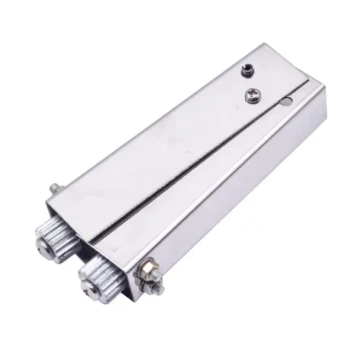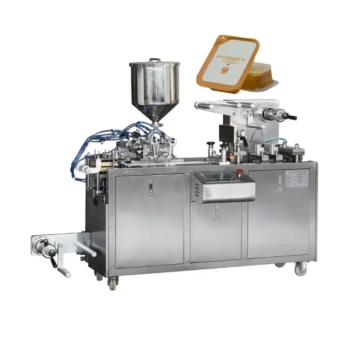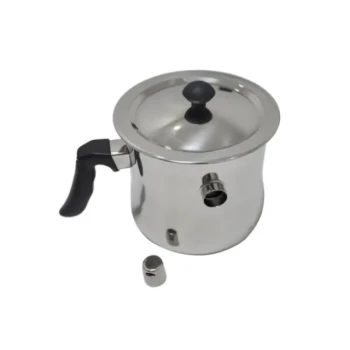For preserving bee pollen, freezing is unequivocally the best method. It is the only technique that effectively halts degradation and maintains the pollen's full nutritional profile, freshness, and potency over long periods. While other methods exist, they involve significant compromises in quality.
The core challenge in preserving bee pollen is its high moisture and nutrient content, which makes it extremely perishable. Your primary goal is to lock in these fragile nutrients before they degrade, and immediate freezing is the most effective way to achieve this.
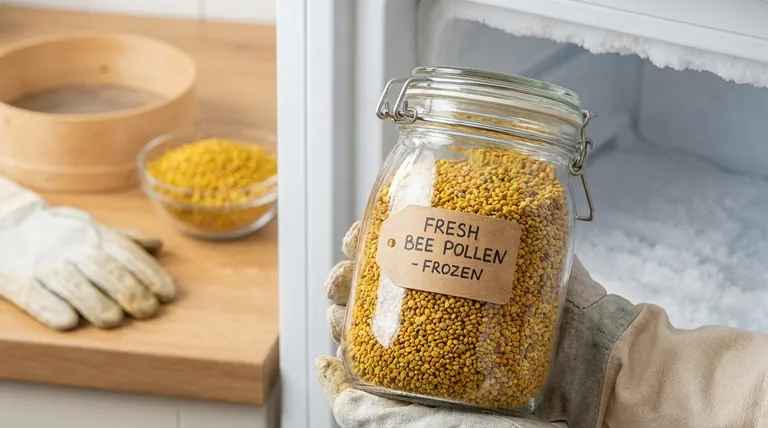
Why Fresh Pollen is So Perishable
The Clock Starts at Harvest
Fresh bee pollen is a living food, rich in water, proteins, vitamins, and fragile fatty acids. The moment it is collected from the hive, this nutritional powerhouse begins to degrade.
Enzymatic activity and microbial growth (like molds and bacteria) start immediately, compromising the quality. This makes swift and proper preservation absolutely critical.
The Gold Standard: Freezing
How Freezing Preserves Nutritional Integrity
Freezing is the industry and scientific standard because it works by halting biological activity at a molecular level. It stops the enzymes from breaking down nutrients and prevents microorganisms from growing without using heat.
This process preserves the delicate vitamins, amino acids, and beneficial fatty acids that would otherwise be destroyed by other methods like drying.
The Correct Freezing Protocol
First, clean the pollen. Sift it to remove any hive debris, bee parts, or other impurities. This step is crucial to prevent mold and contamination during storage.
Next, package it correctly. Use clean, airtight, and moisture-proof containers. Glass jars or food-grade freezer bags work well. Removing as much air as possible minimizes oxidation.
Finally, freeze immediately. For optimal preservation, place the cleaned pollen in the freezer as soon as possible after harvesting. It can be stored this way indefinitely without significant nutritional loss.
For short-term storage (a few weeks), you can freeze the pollen for 24-48 hours to kill any potential pests and then move it to the refrigerator.
Understanding Alternative Preservation Methods
Drying Pollen
Drying reduces the moisture content to prevent spoilage. While this makes the pollen shelf-stable at room temperature, it comes at a high cost.
The heat required for drying, even low-temperature drying, inevitably destroys a significant portion of the vitamins, enzymes, and other heat-sensitive compounds, reducing the pollen's overall nutritional value.
Mixing with Honey or Creating a Tincture
Mixing pollen with honey or using alcohol to create a tincture are also valid preservation techniques. However, they fundamentally change the product.
These methods create a new, value-added product—a pollen-honey blend or a liquid extract—rather than preserving the raw pollen in its original state. They are not ideal if your goal is to have pure, unaltered bee pollen.
Common Pitfalls to Avoid
Delaying Preservation
The biggest mistake is waiting too long. Fresh pollen can begin to mold or ferment in as little as 24-48 hours at room temperature. The process of harvesting, cleaning, and freezing should be treated with urgency.
Using the Wrong Containers
Non-airtight containers allow moisture and oxygen to enter, leading to freezer burn, oxidation, and degradation of the pollen's quality. Always use a container that provides a true seal.
Inadequate Cleaning
Skipping the cleaning step introduces contaminants that can lead to mold growth, even in a freezer. Clean pollen is stable pollen.
Making the Right Choice for Your Goal
- If your primary focus is maximum nutritional value and freshness: Freeze the pollen immediately after cleaning in an airtight container.
- If your primary focus is long-term, shelf-stable storage without a freezer: Dry the pollen, but accept that there will be a significant loss of nutritional potency.
- If your primary focus is creating a value-added product: Mix the pollen with honey or create a tincture for unique applications.
- If your primary focus is feeding your bees: Use fresh or frozen pollen to provide them with the highest quality nutrition.
Ultimately, freezing is the only method that respects the nutritional integrity of the raw pollen.
Summary Table:
| Method | Best For | Key Benefit | Main Drawback |
|---|---|---|---|
| Freezing | Maximum Nutrition | Preserves all nutrients & potency | Requires freezer space |
| Drying | Shelf-Stability | Can be stored at room temperature | Significant nutrient loss |
| Mixing with Honey | Value-Added Products | Creates a new product | Alters the raw pollen |
Ensure your bee pollen retains its maximum nutritional value and market quality.
As a commercial beekeeper or distributor, the quality of your bee pollen directly impacts your product's value and your bees' health. HONESTBEE provides the high-quality beekeeping supplies and equipment—like airtight storage containers and freezers—that are essential for implementing this best-practice freezing protocol at scale.
Contact our wholesale experts today to discuss equipment solutions for preserving your harvest's potency and profitability.
Visual Guide
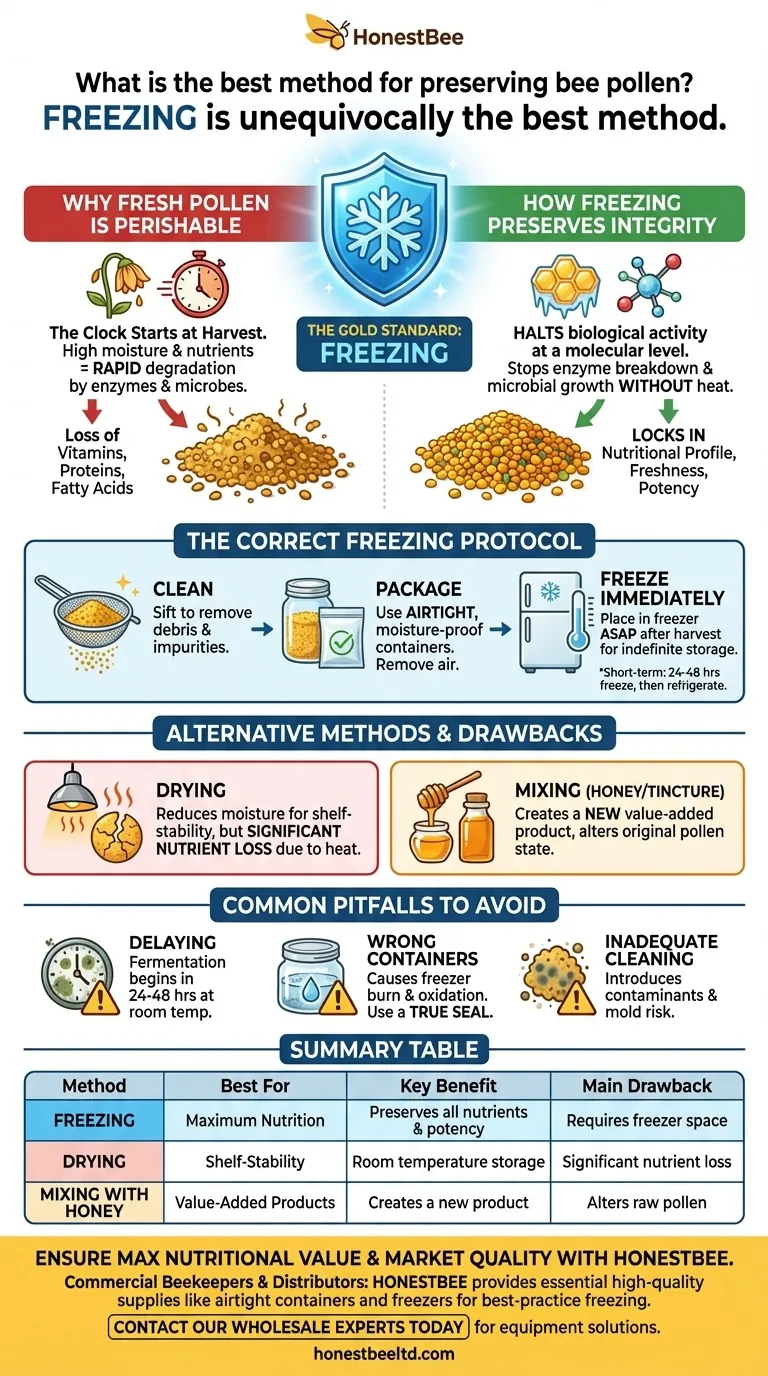
Related Products
- 8-Frame Electric Self-Reversing Honey Extractor Spinner for Commercial Honey Extraction Equipment
- Full Set Beekeeping Electronic Bee Venom Collector Machine Device for Bee Venom Collecting
- HONESTBEE 72 Frame Industrial Electric Honey Extractor for Beekeeping
- Yellow Plastic Bucket Pail Perch for Beekeeping
- Wholesales Dadant Size Wooden Bee Hives for Beekeeping
People Also Ask
- What factors should be considered when choosing the size of a honey extractor? Maximize Your Harvest Efficiency
- What should a beekeeper do after extracting honey from supers? A Guide to Harvest Management
- What is a honey extractor and how does it work? Maximize Your Honey Harvest
- Why is preserving honeycomb integrity important, and how do automated extractors help? Boost Hive Health & Honey Yields
- How do automatic honey extractors function? Achieve High-Efficiency Honey Harvesting





